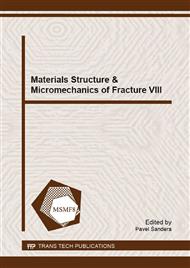p.607
p.611
p.615
p.619
p.623
p.627
p.631
p.635
p.639
The Changes in Mechanical Properties of Austenitic Creep Resistant Steels SUPER 304H and HR3C Caused by Medium-Term Isothermal Ageing
Abstract:
The paper presents the results of the analysis of secondary phases formed during thermal exposure in creep resistant austenitic steels of SUPER 304H and HR3C types. These steels were worldwide used for construction of the superheaters (the heat exchangers) of supercritical and ultra-supercritical (USC) coal-fired power plants. In order to accelerate precipitation processes, the steels were isothermally aged at 675 °C for 20 000 h. The investigations of the precipitates were primarily focused on the occurrence of brittle phases. Changes in mechanical properties caused by occurrence of secondary phases were documented by tensile testing and measurement of the impact strength. For comparison reasons, the impact tests of the initial state of the steels were also performed. The results showed that long-term ageing had led to the significant decrease of the impact strength. Correlation between precipitation of secondary phase and measured values of mechanical properties is shown. The influence of brittle phases on long-term durability of the degraded steel regarding its insufficient impact strength has been discussed.
Info:
Periodical:
Pages:
639-642
Citation:
Online since:
December 2016
Authors:
Keywords:
Price:
Сopyright:
© 2017 Trans Tech Publications Ltd. All Rights Reserved
Share:
Citation:


